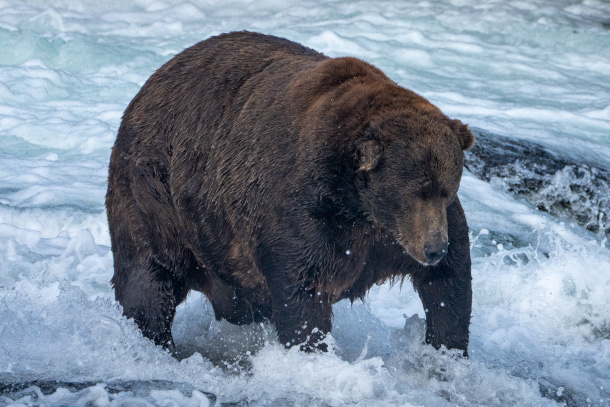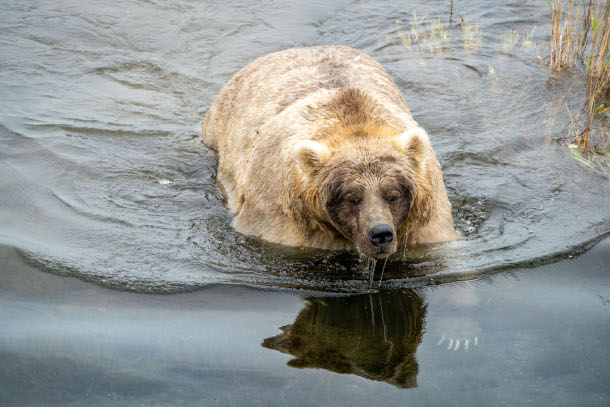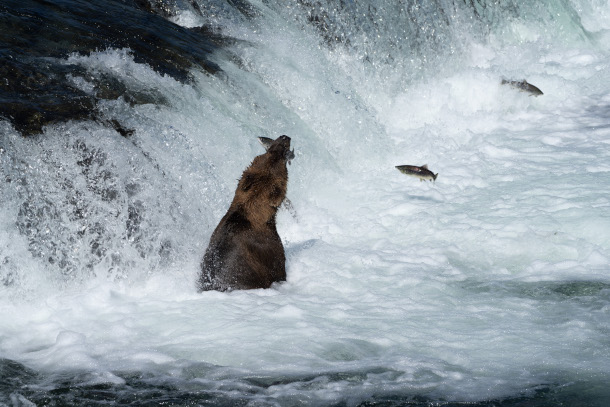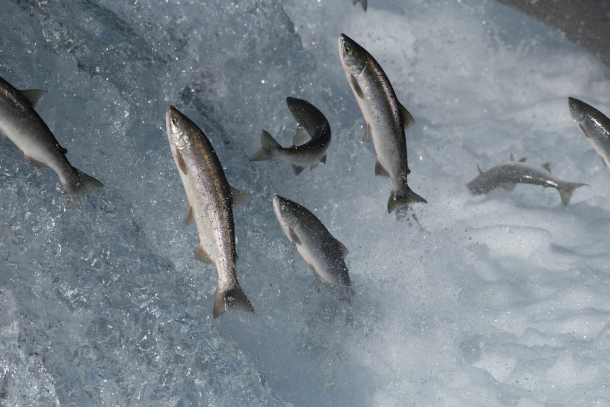Fat Bear Week and the Salmon Behind It All
Air Date: Week of October 21, 2022

Bear 747 is 2022’s Fat Bear Week winner, estimated to weigh around 1,400 pounds. (Photo: Courtesy of L. Law, Katmai National Park and Preserve)
Every year Katmai National Park in Alaska hosts Fat Bear Week, a competition to determine voters’ favorite chubby brown bear, because come autumn a fat bear is a healthy bear with plenty of fat reserves to get them through the long frigid Alaskan winter. Katmai National Park ranger Felica Jimenez joins Host Jenni Doering to discuss this year’s winner, how much weight bears gain before hibernation, and why salmon are the unsung heroes of Fat Bear Week.
Transcript
DOERING: Katmai National Park and Preserve in southwest Alaska is part of a vast boreal forest that is vital for ecological balance and protects large numbers of grizzly bears. To get through the long frigid Alaskan winters these bears need to pack on the pounds, and some get so big humans now have a competition called Fat Bear Week. The winners aren’t necessarily the baddest bears, but they’re among the biggest. Fans from around the world vote online for their favorite of the massive brown bears captured on camera. The competition this year was so intense that the staff at Katmai even had to sniff out voter fraud. Of course, the bears were blissfully unaware of that and just kept on feasting on the plentiful salmon in the Brooks River. Felicia Jimenez is a park ranger with Katmai National Park and Preserve and she’s here with the details of Fat Bear Week 2022. Felicia, welcome to Living on Earth!
JIMENEZ: Hi, thank you for having me.
DOERING: So who won this year? What are some fun facts about the winner?
JIMENEZ: The winner this year was Bear 747. This is actually his second crown, which is really well deserved because he's a massive bear. He's probably one of the largest brown bears on Earth. And in 2019, he was estimated to weigh about 1,400 pounds. He is one of the most dominant males in the Brooks river hierarchy. And he actually starts off pretty massive already, usually emerging from the den still carrying some of his weight from the previous year.
DOERING: Wow, that's amazing. That's a huge bear. So with the name like 747, was that just a random string of numbers that he got? Or was it you know, this is a big bear, we need to give it a big Boeing 747 sized name?
JIMENEZ: Yeah, it's funny. It's a coincidence. He was identified as a subadult. And when he was first seen, he was actually really small. But he's definitely grown into his number. It's pretty funny.
DOERING: Wow, the comeback kid, I guess. So last time, we covered fat Bear Week, Holly was the big winner. How did she do this year?

Bear 435, Holly, was the runner-up in this year’s Fat Bear Week. (Photo: Courtesy of L. Law, Katmai National Park and Preserve)
JIMENEZ: Yeah, Bear 435, Holly, she did really well this year still. This year she actually just emancipated her cub 335, as a subadult who was also in the competition. And returning as a single bear kind of gave her a little bit of an advantage because she doesn't have to provide for a cub, she doesn't have to, you know, sacrifice those resources. So she could just focus on feeding herself. And it proved to pay off. She did really well as a previous winner. She started with the first round by, she won her first matchup against Bear 164, and then in the semifinals, she went up against 747. And she did lose. But even though she lost, she is still doing really well. She looks really massive, and she's definitely gained enough weight to set herself up for a successful hibernation.
DOERING: Oh, that's really great. Now I was wondering, so, of course, there are male winners, there's female winners. What about when a bear is an expecting mother? Does that sort of add some bulk and maybe give them a little bit of an edge in Fat Bear Week?
JIMENEZ: In the biographies it probably does, because it's a subjective competition. And maybe people see in their biographies, oh, this is a sow with cubs, I'm gonna vote for her. But for the most part, biologically, bears actually have a really cool thing called delayed implantation. So those embryos will not actually implant in the uterus without gaining substantial fat reserves. So I mean, a bear could have mated and have those embryos there, fertilized eggs there, just waiting. But they won't actually implant until they reach hibernation, and they've gained enough fat. So sows actually have a higher stake in gaining those fat reserves.
DOERING: Wow, that's amazing. So they're just hanging out until their body's ready to have a pregnancy. They're just waiting and eating all the salmon they can possibly find, right?
JIMENEZ: Yeah, yeah. And I mean, if a bear gains more weight, potentially they could have more embryos implant so that means more offspring. So that's a really, really cool fact about bears.

Bears congregate at Brooks Falls in Katmai National Park every year to catch salmon and bulk up before they hibernate. (Photo: Courtesy of L. Law, Katmai National Park and Preserve)
DOERING: Who were some of the runners up and who were you secretly rooting for?
JIMENEZ: So in the final bracket, Bear 901 was the runner up, and I really wanted her to win. She was kind of a dark horse during the competition, but she very quickly gained a following. And it's easy to see why she gained such a following. She started off really, really small when she showed up in the beginning of the summer, and she's ballooned into this massive blimp of a bear. She was clearly very successful at gaining weight for the winter. And she's had such a massive transformation and did so well as a completely unknown bear making it to the final round. Even though she didn't win, I'm sure we'll see big things from her in future competitions.
DOERING: So how much weight are we talking about in Fat Bear Week? How much do they weigh when they come out of hibernation in the spring, and they start eating these salmon in the Brooks River, and throughout the summer, they gain all this weight and how much are we talking?
JIMENEZ: It's a lot, yeah. Males typically can start between six and 900 pounds in the beginning of the summer. And then they can weigh anywhere, you know, over 1,000 pounds. And I mean 747 is estimated to weigh about 1,400 pounds. It's a big transformation. Sows can weigh in the beginning of the summer between four and 600 pounds and then they can get anywhere within the 700-to-900 pound range. So it's about a third of their body weight that they're losing when they're in hibernation, and then they emerge from the den.
DOERING: And this food that they feed on, mostly salmon, I believe, maybe berries as well, but like, tell me about that food source and why they're so good at putting on that weight really quickly.
JIMENEZ: Yeah, yeah, it's mostly salmon. In Katmai National Park, it's the sockeye salmon. They're really the unsung heroes of the competition. Without that strong sockeye salmon run, we wouldn't have Fat Bear Week. The timing of the bears showing up at the Brooks River coincides with that salmon run and July is when the run starts. And so we'll see a lot of the bears concentrate in the Brooks Falls area, because that's where the salmon are swimming upstream to spawn. And then we'll see the bears concentrate once again, in the lower portion of the river in September, when the salmon have spawned out, they're dying. So they're washing up on the shores of the river, and then the bears can just pick them off. So it's mostly those two months when we see our highest concentrations of bears. That's what's supporting the weight gain of the bears during the summertime.

Fat Bear Week would not be possible without a healthy sockeye salmon run on the Brooks River. (Photo: Courtesy of Russ Taylor, Katmai National Park and Preserve)
DOERING: In a lot of the West we've heard about salmon populations declining. But how are the salmon doing up in the Brooks River and Brooks Falls area where these bears get so fat over the course of one summer?
JIMENEZ: Yeah, that's actually a big cause of our celebration. We're very, very fortunate at Katmai that our sockeye salmon run is doing so well, especially with the Bristol Bay watershed that salmon run was actually record breaking this summer. But we do know that it's not like that in all places of the world. It's also not a guarantee for Katmai. And Fat Bear Week allows us to exemplify just how pristine our sockeye salmon run is doing. Because it's not like that everywhere.
DOERING: Felicia, what's your favorite part of Fat Bear Week?
JIMENEZ: Last year was kind of my first year seeing that Fat Bear Week was a thing. I think my favorite part of Fat Bear Week is just seeing, you know, behind the scenes, how much joy it brings people and how people are so excited and schools want to participate, people in, like, offices want to participate. I love seeing it.
DOERING: Felicia Jimenez is a park ranger with Katmai National Park and Preserve. Felicia, thank you so much for taking the time with us today.
JIMENEZ: Thank you for having me. It was a lot of fun.
Links
Learn more about Fat Bear Week and see previous winners
Click here to view Katmai’s bear webcams
Living on Earth wants to hear from you!
Living on Earth
62 Calef Highway, Suite 212
Lee, NH 03861
Telephone: 617-287-4121
E-mail: comments@loe.org
Newsletter [Click here]
Donate to Living on Earth!
Living on Earth is an independent media program and relies entirely on contributions from listeners and institutions supporting public service. Please donate now to preserve an independent environmental voice.
NewsletterLiving on Earth offers a weekly delivery of the show's rundown to your mailbox. Sign up for our newsletter today!
 Sailors For The Sea: Be the change you want to sea.
Sailors For The Sea: Be the change you want to sea.
 The Grantham Foundation for the Protection of the Environment: Committed to protecting and improving the health of the global environment.
The Grantham Foundation for the Protection of the Environment: Committed to protecting and improving the health of the global environment.
 Contribute to Living on Earth and receive, as our gift to you, an archival print of one of Mark Seth Lender's extraordinary wildlife photographs. Follow the link to see Mark's current collection of photographs.
Contribute to Living on Earth and receive, as our gift to you, an archival print of one of Mark Seth Lender's extraordinary wildlife photographs. Follow the link to see Mark's current collection of photographs.
 Buy a signed copy of Mark Seth Lender's book Smeagull the Seagull & support Living on Earth
Buy a signed copy of Mark Seth Lender's book Smeagull the Seagull & support Living on Earth

